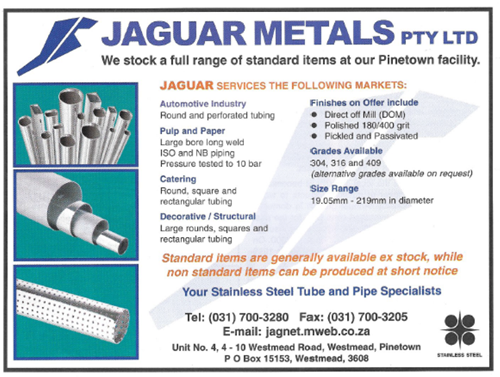- Making Stainless Even Better
- Sassda News
- New Alloy to Combat Cost of Nickel
- A Brighter Future For Stainless
- Markedly Different Trading Environment
- Czech-Mate
- Building the Use of Stainless
- New Stainless Project
- Latest on SSCDI Activities
- The Currency of the Future
- New Autocat Factory
- Partnering Alliances Froth Up Market
- Stainless for Millennium Bridge
- South Africa’s Stainless Sector Shines Bright
- Sector Fails to Steel Itself for E-Commerce
- Stainless in Space
- Using Stainless for LPG Cylinders is a Gas
The newly-published Sassda statistical survey has confirmed that the local stainless sector remains one of the fastest-growing in the world. Stainless Steel speaks to Ken Dewar, Scott Houslay and Neels van Niekerk to update the activities of the Stainless Steel Co-operative Development Initiative (SSCDI), and find out what is in the pipeline.
Alec Erwin, Minister of Trade and Industry, has said that the local stainless industry is one of the country’s key competitive advantages. “We have the energy, the raw materials and the experience and skill in producing it. We are so convinced of this that we believe we should think big.”
So big, in fact, that the SSCDI has set itself an initial target of increasing the local conversion of stainless to 300 000 tons of fabricated products by 2006, which represents nearly a threefold increase in consumption.
“We believe that stainless should be one of South Africa’s great strengths. But we have to think of the whole pipeline, the associated industries, and how we can begin developing those associated industries, to ensure we create a stable and substantial manufacturing base utilising stainless as a basic input.
“The approach we are taking is to continually seek for opportunities and possibilities for the utilisation of stainless and its export. Any South African manufacturing process has to conceive of itself at the very outset also as an exporting process. We are just not large enough, as a single economy, to sustain world-competitive production processes in the world today.”
Spanish stake in Columbus
Erwin’s words were prophetic, for in late July Highveld Steel, Samancor and the Industrial Development Corporation, partners in the Columbus joint venture, signed a non-binding understanding with Acerinox of Spain in terms of its possible acquisition of a 64% stake in the local producer from 1 January, 2002 for 232-million euros. This aligns Columbus with the most modern stainless group worldwide.
The government’s emphasis on stainless exports has also borne fruit, with exports of stainless fabricated products rising by 10% from 56 200 to 62 000 tons last year. This marks the first time in the history of this industrial sector that sales of fabricated products into the export market exceeded demand for fabricated products in the local market.
“It is pleasing to note that the local industry is becoming a globally-competitive supplier of quality products to world markets,” comments Houslay. Annual growth in domestic apparent consumption has averaged over 18% for the past 15 years, compared with 6% globally. Apparent consumption grew from 118 700 in 1999 to 123 300 tons in 2000. On the negative side, local demand declined from 62 500 in 1999 to 62 200 tons in 2000.
Houslay says that domestic economic forces and the diversion of disposable income to other products have hit demand for stainless consumer products hardest. Despite the growth of the population and its improved access to housing and other basic facilities, demand for affordable quality items such as cutlery and hollowware appears to be dropping. “But it is likely that this is not the real situation. While the statistics show a drop, we believe illegal imports are affecting the situation, and these are being investigated.”
In addition, the lack of capital projects has also taken its toll in the fabricating, foundry and metal-forging industries. However, there are encouraging signs that this situation is being reversed temporarily this year, with many fabrication facilities now operating close to capacity, processing substantial capital equipment orders for the petrochemical, food, fruit and wine sectors.
“There is no doubt that the future of the stainless industry is positive. The sector offers exceptional opportunities for downstream value-added operations,” says Houslay. And the SSCDI plays a critical role in identifying and facilitating these opportunities, with the Department of Trade and Industry (DTI) having made R3-million available over a three-year period to help pave the way.
Value-chain study
In terms of the local catalytic converter industry, a value-chain study is being undertaken to ensure the competitiveness of the sector following a possible new regulatory environment introduced when the current Motor Industry Development Programme expires. It is hoped that the sector could be expanded to look at the entire exhaust train system, and not just catalytic converters in isolation, postulates Dewar. “We are exhibiting at an automotive show in Paris in October in order to highlight the capability of the local automotive industry,” he reveals.
Other research that the SSCDI is involved with includes semi-finished components, e-commerce, consumer products, telephone booths, expanded-metal products and roofing. “The advance in structural products means it is now possible to put up an entire building in stainless,” says Van Niekerk. Trident Midrand Steel is pioneering the way with 3CR12 stainless long products in conjunction with Iscor.
The use of stainless in architecture is focused mainly on surface finishes, which accounts for very little tonnages. We are relooking at the architectural, building and construction sector at present to identify the tonnage points,” says Houslay. Some of the biggest traditional consumers of stainless are such areas as mining and sewerage plants, which are being targeted afresh by Columbus’s revamped sales team.
“Columbus is aiming to reassert its presence in the industry, particularly those areas where the emphasis on stainless has changed,” says Dewar. “The constant turnover in personnel in these industries means you have specifiers who are unfamiliar with the product. We have to keep the decision-makers up to date by feeding them a constant stream of information.


